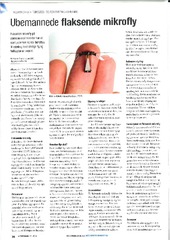Blar i forfatter Artikler, rapporter og annet (elektroteknologi) "Oland, Espen"
-
Attitude Determination and Control System for Satellites in Elliptical Orbits - a Complete Solution
Oland, Espen (Konferansebidrag; Conference object, 2017-08-08)This paper presents a complete solution to the problem of attitude determination and control for satellites in elliptical orbits. Specifically, it shows how to create the orbital mechanics, account for perturbing gravity torques, create a nonlinear PD+ attitude controller, map the control signal to desired thrust firings, implement magnetic field and Sun vector models, and how to implement a Madgwick ... -
Autonomous Inspection of the International Space Station
Oland, Espen (Konferansebidrag; Conference object, 2017-09-18)This paper presents a solution to autonomous inspection of the international space station using a rigid spacecraft. Specifically, the paper presents the orbital mechanics, formation dynamics as well as rotational dynamics required to control the spacecraft relative to the space station, and then presents two PD+ controllers enabling a spacecraft to track a series of waypoints while pointing a sensor ... -
A Comparative Study of Different Control Structures for Flight Control with New Results
Oland, Espen; Kristiansen, Raymond; Gravdahl, Jan Tommy (Peer reviewed; Book; Chapter, 2018-10-24)This paper presents several different control structures that facilitate flight control and does a comparison between them. Specifically, this paper considers command-filtered backstepping, nonlinear dynamic inversion (NDI), and a new decoupled approach that decouples the rotational and translational dynamics by estimating the higher order derivatives of the angle of attack and sideslip angle. The ... -
Controlling a Chain of Integrators with Constrained Actuation Using Exponential Activation Functions
Oland, Espen; Kristiansen, Raymond (Peer reviewed; Chapter; Bokkapittel, 2019-10-24)This paper shows how to control a chain of integrators with constrained actuation by using exponential activation functions. Specifically, it shows how the control law can be decomposed into several parts that can be activated as they are required, resulting in a simple control law that is able to make the states converge fast to zero. -
A Decoupled Approach for Flight Control
Oland, Espen; Kristiansen, Raymond (Journal article; Tidsskriftartikkel; Peer reviewed, 2016)A decoupling method for flight control is presented that greatly simplifies the controller design. By approximating the higher order derivatives of the angle of attack and sideslip, it enables a rotation controller and a speed controller to be derived independently of each other, and thus gives access to a vast number of controller solutions derived for general classes of rotational and translational ... -
Modeling and Attitude Control of Satellites in Elliptical Orbits
Oland, Espen (Peer reviewed; Chapter, 2018-11-05)The attitude determination and control system (ADCS) for spacecraft is responsible for determining its orientation using sensor measurements and then applying actuation forces to change the orientation. This chapter details the different components required for a complete attitude determination and control system for satellites moving in elliptical orbits. Specifically, the chapter details the orbital ... -
Preliminary Results on Waypoint Tracking for Spacecraft with Actuator Constraints
Oland, Espen; Andersen, Tom Stian (Peer reviewed; Chapter; Bokkapittel, 2019-07-22)This paper presents preliminary results on how to perform waypoint tracking with spacecraft with actuator constraints. It considers a simplified spacecraft model and can be considered a deep space model, and shows how to perform waypoint tracking with only one main thruster together with full attitude control. As the spacecraft reaches close to the waypoint during a deceleration phase that makes the ... -
Real-Time Particle Tracking using a Formation of UAVs
Oland, Espen; Kristiansen, Raymond (Journal article; Peer reviewed; Tidsskriftartikkel, 2013)In this paper the problem of real-time particle tracking is studied. Using sensor measurements, a formation of UAVs autonomously find the closest point with high particle density where they enter a holding pattern. After converging to the holding pattern, one UAV will remain, while the rest will go looking for other maxima. To avoid collisions between the UAVs during the mission, a controller is ... -
Stabilization of Non-Cooperative Satellites in Low Earth Orbits using Inter-Satellite Atmospheric Drag
Oland, Espen; Kristiansen, Raymond (Chapter; Bokkapittel, 2023-08-07)This paper presents a novel solution to the problem of stabilization of non-cooperative satellites in low Earth orbits, which utilizes inter-satellite aerodynamic drag effects for generation of aerodynamics moments in the wake of a controlled satellite. Hence, by altering the position of a smaller controlled satellite, we are able to change the wake region and thus provide aerodynamic moments for ... -
Subsumption architecture applied to flight control using composite rotations
Oland, Espen; Andersen, Tom Stian; Kristiansen, Raymond (Peer reviewed; Tidsskriftartikkel; Journal article, 2016-03-19)In this paper the subsumption theory is applied to flight control through composite rotations where multiple tasks can be defined as simple rotations. The tasks can then be arranged as a hierarchy, where the primary task is always fully pursued, and conflicting lower level tasks are removed by the primary rotation. The concept is applied to a group of uavs that move through an urban terrain while ... -
Ubemannede flaksende mikrofly
Oland, Espen (Journal article; Tidsskriftartikkel, 2013) -
Underactuated Control of Quadrotors with Collision Avoidance
Oland, Espen; Andersen, Tom Stian; Kristiansen, Raymond (Journal article; Peer reviewed; Tidsskriftartikkel, 2013)In this paper a saturated controller is derived that solves the translational control problem for underactuated quadrotors. The controller is applied to multiple quadrotors during a formation reconfiguration where the quadrotors move from an initial position to a desired position. The null-space-based behavioral control method is a popular method for avoiding collisions between mobile agents, and ... -
Underactuated Waypoint Tracking of a Fixed-Wing UAV
Oland, Espen; Schlanbusch, Rune; Kristiansen, Raymond (Journal article; Peer reviewed; Tidsskriftartikkel, 2013)In this paper a new method of performing waypoint tracking is shown for underactuated fixed-wing UAVs. The position error can be mapped onto the desired axis using a desired rotation matrix, while the velocity error can be mapped to the desired axis using a desired angular velocity. With all errors defined along one axis, the tracking problem is easily solved using only one thruster. A velocity ...


 English
English norsk
norsk











